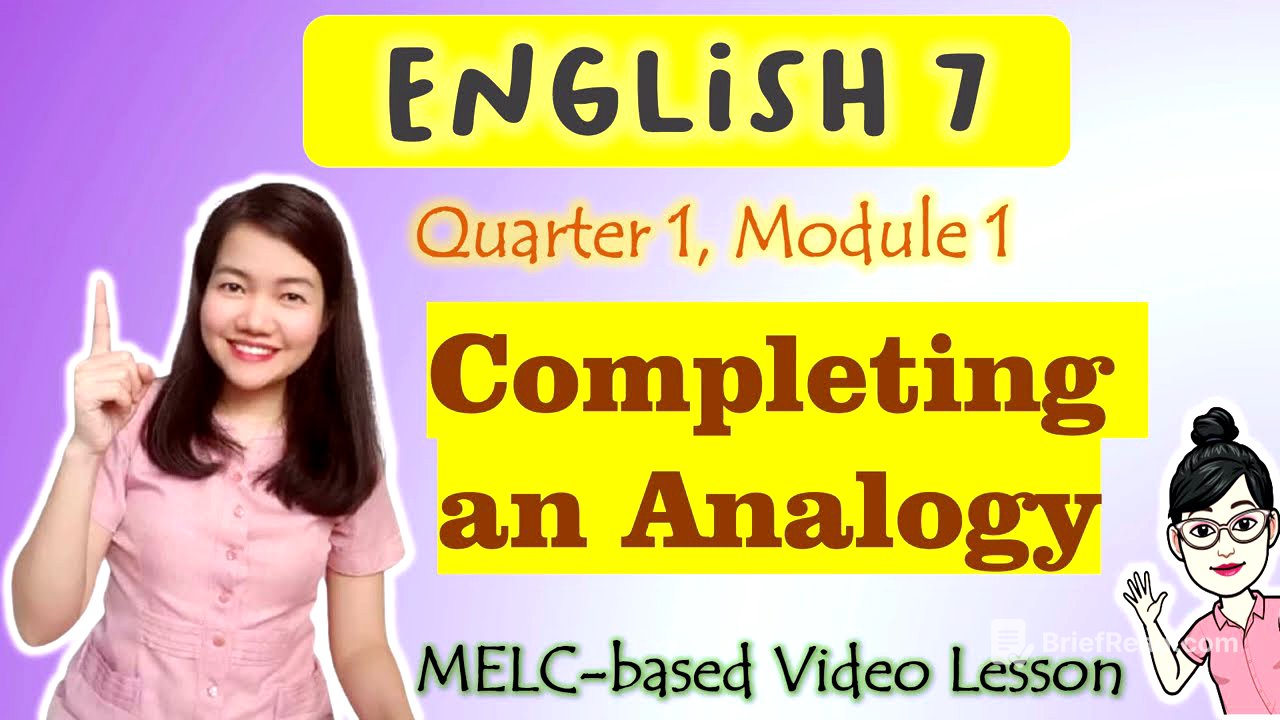TLDR;
This video by English Teacher Ni Juan introduces the concept of analogies, explaining what they are, how they work, and different types of analogies with examples. The video aims to improve viewers' reasoning ability by understanding relationships between words, phrases, numbers, or illustrations.
- Definition and purpose of analogies
- Tips for completing analogies
- Ten different types of analogies with examples
Introduction [0:36]
The video welcomes junior high school students to a new chapter of English lessons. The teacher expresses her commitment to helping students understand English 7 lessons more effectively through these videos. The first lesson focuses on completing analogies, aiming to enhance the viewers' ability to analyze relationships presented in analogies.
Analogy Explained [1:22]
The lesson starts with a simple exercise: "Brewed coffee is to cup as chicken soup is to ____." The video emphasizes the importance of understanding the relationship between the first pair of words to find the correct answer. Analogy, derived from the Greek word "analogia," means proportion or equality of ratios. It explains the relationship between words and ideas, often comparing objects to show similarities in certain features. Verbal analogy is a tool to measure reasoning ability.
Tips for Completing Analogies [3:40]
The video provides tips for successfully completing analogies. First, read the analogy as a sentence. Then, express the relationship between the first two words. Substitute the third word for the first and find a suitable substitute for the second word. Express a relationship between the first and third words by substituting the second word for the first and figuring out a suitable substitute for the fourth word.
Opposite Analogy [4:36]
Opposite analogy involves words with opposite meanings. Examples include "crying is to laughing" and exercises like "hot is to cold as yes is to no" and "good is to bad as heaven is to hell."
Object and Classification Analogy [5:14]
Object and classification analogy classifies objects into groups. A single object can be classified into different groups. For example, "spoon is to kitchen utensil while a trowel is to garden tool." Other examples include "boots is to footwear as swimsuit is to swimwear" and "barong is to men as baro't saya is to women."
Object and Related Object Analogy [5:58]
Object and related object analogy involves objects related to each other. Examples include "plant and seed," "spoon is to fork as pen is to paper," and "flower is to vase as picture is to frame."
Cause and Effect Analogy [6:30]
Cause and effect analogy relates two things where one is the cause and the other is the effect. Examples include "fire and burn" and "read and learn." An exercise provided is "virus is to illness as carelessness is to accident."
Degrees of a Characteristic Analogy [7:05]
Degrees of a characteristic analogy often uses adjectives to show varying degrees of a trait. Examples include "tired and exhausted" and "cold and freezing." The exercise is "glad is to happy as sad is to lonely."
Object and Group Analogy [7:34]
Object and group analogy involves several objects forming a group. Examples include "trees and forest." The exercise is "musicians is to band as teachers is to faculty."
Problem and Solution Analogy [8:01]
Problem and solution analogy relates a problem to its solution. Examples include "tired and sleep." The exercise is "hungry is to eat as thirsty is to drink."
Effort and Result Analogy [8:30]
Effort and result analogy relates an effort to its outcome. Examples include "paint and painting" and "write and letter." The exercise is "plant is to harvest as cook is to meal."
Object and Function Analogy [8:59]
Object and function analogy relates an object to its function. An example is "keyboard and to type." The exercise is "printer is to print as television is to watch."
Performer and Action Analogy [9:27]
Performer and action analogy mentions both the performer and their action. Examples include "painter and paint." The exercise is "singer is to sing as actor is to act."
Conclusion [9:52]
The video concludes by encouraging viewers to be keen and eager in analyzing relationships and connections between words, phrases, numbers, and illustrations to sharpen their minds and improve reasoning ability. The teacher encourages viewers to subscribe and turn on notifications for more video tutorials.
